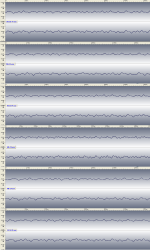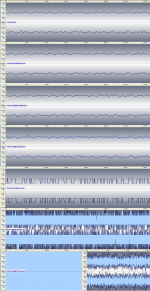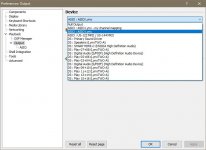Anyone can program BADLY. The state of the average website is proof of that.
And to counter your argument I will use a single Acronym COBOL. So since 1958 anyone can program, just back then they didn't have access to systems to do it on.
(as an undergrad I was told FORTRAN was all I ever needed. How wrong they were)
Wow, you must be really old. I'm old, and when I was in high school I learned FORTRAN, BASIC, and APL. They told us FORTRAN was big in North America but ALGOL was big in Europe. They also mentioned COBOL as something financial types used, though they failed to mention Y2K (still 25+ years in the future). When I was an undergrad they forced us to learn and use PL/1, which had the advantage of being whatever you wanted (at least 3 variants in use at that school, SP/K, PL/C, and PLUTO). One of the first assignments was to write a compiler that would take simple arithmetic instructions (like x=y+3) as input, and output assembler for an imaginary processor.
Speaking of assembler, one of my profs at another school had a lovely program he wrote which showed a block diagram of a fairly simple CPU and allowed you to program it and watch the instructions decode and flow through the various functional units. He wrote it in C but the course I was taking from him was Intel assembly language programming. This was in the continuing ed. department, I don't know what undergrads were learning.
APL? Seriously? I had 1 minute on APL on my engineering course basically to show it was terse to the point of unreadability.
@Demian: Server had been tucked up for the night when I got your email, will check settings tonight when I get home. I have never bothered punching a hole through the broadband router firewall to get external access as I then open up a whole new world of patch pain.
@Demian: Server had been tucked up for the night when I got your email, will check settings tonight when I get home. I have never bothered punching a hole through the broadband router firewall to get external access as I then open up a whole new world of patch pain.
The HD recording I have linked to, starts with a 2.5sec silent section, in which only the recording venue ambient noise is present (see 1st attachment for a high resolution FFT from this silent section)
2nd and 3rd attachments are zoom-in waveshapes from this silent section of all the files I’ve uploaded at dropbox.
4th attachment is the statistics from the silent section of all the files.
Notice how many bits does the low level ambient noise occupies (and keep in mind that dither works at the 1-2 LSBs )
George
2nd and 3rd attachments are zoom-in waveshapes from this silent section of all the files I’ve uploaded at dropbox.
4th attachment is the statistics from the silent section of all the files.
Notice how many bits does the low level ambient noise occupies (and keep in mind that dither works at the 1-2 LSBs )
George
Attachments
APL? Seriously? I had 1 minute on APL on my engineering course basically to show it was terse to the point of unreadability.
Yeah, I never said I like it. 🙂 Math types seemed to dig it, but to me it was the opposite of a programming language.
Thanks George for this effort.
- Integer SRC is distinctly preferable to non integer SRC.
You are welcome Dan
Non Integer SRC is certainly more computation power intensive.
But the process is as much well defined and as much reversible as with Integer SRC.
When done on the fly on a device with limited computational or memory resources , it can make the device run at the limits of it’s capabilities, maybe this is what makes you think non integer SRC is problematic ( i.e. the result is device dependent).
- Reduction in SR distinctly reduces audible information.
It only adds another LP filter with a lower cut off frequency.
http://www-pagines.fib.upc.es/~pds/Lect07.pdf
George
It only adds another LP filter with a lower cut off frequency.
George
Okay, maybe Dan meant HF audible information is lost?
What some people might refer to as a loss of some "detail."
Although, that term might refer to the effects of other possible distortions as well, besides what might be included as frequency distortion.
2nd and 3rd attachments are zoom-in waveshapes from this silent section of all the files I’ve uploaded at dropbox.
It should be noted, however, that the waveshapes shown appear to be unreconstructed, as is normally the case in a digital audio workstation. Thus, the very rough looking undithered example would be smoothed somewhat during playback.
Okay, maybe Dan meant HF audible information is lost?
What some people might refer to as a loss of some "detail."
Although, that term might refer to the effects of other possible distortions as well, besides what might be included as frequency distortion.
Mark, work is still in progress on this, to see what I can find. There will be one –two more posts with some findings from me.
After all, it was Dan that fed my curiosity and made me look into all this. I feel I have to satisfy his good intentions, regardless if we end not agreeing on a few (or on all) things 🙂
It should be noted, however, that the waveshapes shown appear to be unreconstructed, as is normally the case in a digital audio workstation. Thus, the very rough looking undithered example would be smoothed somewhat during playback.
That’s correct.
The intent was to show that there is no waveshape change up to and including the 16 bit versions.
I included the ugly looking 8 bit for completeness.
But on the 8 bits it’s not the looks, it’s the amplitude that is the take away (the "we can hear details hidden deep in the noise").
Again, I am still working on the low level thing

George
The intent was to show that there is no waveshape change up to and including the 16 bit versions.
There has to be some waveshape change. If you stretched out or magnified the waveforms enough, the differences would be more visible.
I had a lot of trouble getting the 96kHz file to play back at the correct sample rate in Windows. Windows doesn't say anything, but by default it was downsampling to 16/44.1 on the fly in realtime, which did not sound good. I could see what it was doing from the Lynx2 mixer control panel, which shows the sample rate and bit depth being received from Windows.
The fix was to go to Windows control panel, sound, select the playback device, select properties, advanced tab, then set shared mode sample rate to 24/96. After than the hi-res file plays correctly, and sounds very nice.
Mark
Thank you very much for bringing to our attention this elephant in the room.
Today I went to a computer store and I was checking the audio settings on all the demonstration laptop PCs running Windows 10 (home).
There were many that had the audio format selection tab locked at 44.1/16 only.
And this wasn’t an exclusivity of the lowest price range. Some PCs at 1000 Euro had the tab locked.
My daughter’s 500 Euro Win10 laptop does 44.1, 48, 96 and 192k both at 16 and 24bit.
My Win XP SP3 (home) PC goes up to 48k/whatever bits. Even with it’s ASIO drivers, my USB card isn’t allowed to go above 48k
George
Yeah, that's what I had do do.
My laptop does all the sample rates and 16/24 bit if I manually go in and change according to particular tracks.
I investigated an ASIO plugin for Foobar that but couldn't get it to appear in Foobar preferences, I haven't gotten back to solving that.
All round word is that Windows audio needs to be bypassed for bit perfect replay.
Dan.
My laptop does all the sample rates and 16/24 bit if I manually go in and change according to particular tracks.
I investigated an ASIO plugin for Foobar that but couldn't get it to appear in Foobar preferences, I haven't gotten back to solving that.
All round word is that Windows audio needs to be bypassed for bit perfect replay.
Dan.
I investigated an ASIO plugin for Foobar that but couldn't get it to appear in Foobar preferences, I haven't gotten back to solving that.
The procedure I used to install ASIO was to download the component, then go to preferences, the go to the top menu in preferences, "components," to import/install the ASIO component, then may have had to restart foobar (not sure). After that, there were some new options in Preferences->Output, and Preferences->Ouptut->ASIO. The ASIO preferences allow custom channel routing, and use of 64-bit drivers. Once installed, it's necessary to go to the Preferences->Output page and use the drop down menu to select the ASIO device driver you want to use (as per attached image).
In addition, I find that when I open foobar and try to play a file using ASIO, it tends to result in silence on the first try. I have to hit the stop playback button, then play. But only need to do that once after opening foobar, after that no problems, until the next time I start up foobar and have to repeat the procedure. Apparently, it doesn't connect to the ASIO device on the first try.
Attachments
Even with it’s ASIO drivers, my USB card isn’t allowed to go above 48k
It may be that USB-1 only had enough bandwidth for bidirectional communication up to 48kHz stereo, and only record or playback (one or the other), at 96kHz (if the audio device happened to support that higher sample rate).

I unplugged all the other USB devices and now the USB soundcard in single mode records at 96k both as ASIO and as MME-WDM device.
In dublex mode only to 48k.
Thanks again Mark
George
The one format I have doubts about is CD. Friends spend a fortune on small improvements. If a CD is stored on a computer sometimes it is easier for me to listen to. I speculate that in storing the data perhaps a small improvement has been made ( despite the computer being a sewer of noise ). Nicam style FM is fine as is better MP3 and TV version ( I was dead against it ). Could it be something the CD does isn't as nice as th other formats? I was told CDR copies can sound better. Some I have seem nicer. An RAF guy showed me the machinery they use for aircraft showing jitter errors that he thought not usually measured ( a simpler version of the aircraft rig ). He admitted that this started when trying to improve aircraft the opposite happened. They need measurements to prove what wasn't correctly understood. One was, why did noise damping materials make the aircraft louder! It's very rare I meet people like that who only want the real answer and not ones that suits their beliefs ( I know, that includes me ). Can you imagine being the one who reversed the controls at Mach 1 and lived.
The one format I have doubts about is CD. Friends spend a fortune on small improvements. If a CD is stored on a computer sometimes it is easier for me to listen to. I speculate that in storing the data perhaps a small improvement has been made ( despite the computer being a sewer of noise ). Nicam style FM is fine as is better MP3 ...
When you listen to CDs on a CD player verses those stored on a computer, are they being played back through the same DAC?
Is this a weak attempt at humour? If you take an uncompressed format (e.g. CD) and store it in an uncompressed (or losslessly compressed) computer data file then exactly the same data is stored, so no improvement in the data is possible. If the data file uses lossy compression then a lot of data is thrown away, which is extremely unlikely to improve fidelity.nigel pearson said:I speculate that in storing the data perhaps a small improvement has been made
Now it could be that a particular computer is better at delivering the same bits at the right time than a particular CD player, but even that is unlikely.
I am surprised noone has suggested (a) storing the data as file1; (b) encrypting file1 using encryption algorithm1 and storing the encrypted result as file2; (c) decrypting file2 and storing the result as file3; (d) sending file3 to a DAC for playback. Besides exercising the disk read/write circuits 3 times, this approach flips about half of all the bits, and then flips them back. Surely THAT will change the sound, and probably for the better!
You could experiment with different encryption algorithms (ROT13 ; DES ; RSA ; AES) and different encryption keys, to find out which ones give the most pleasant listening experience.
You could experiment with different encryption algorithms (ROT13 ; DES ; RSA ; AES) and different encryption keys, to find out which ones give the most pleasant listening experience.
- Status
- Not open for further replies.
- Home
- General Interest
- Everything Else
- What is wrong with op-amps?




